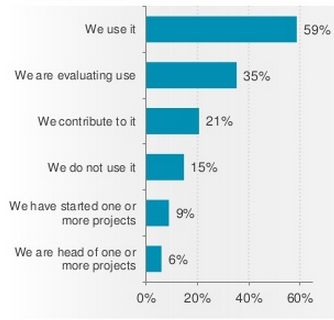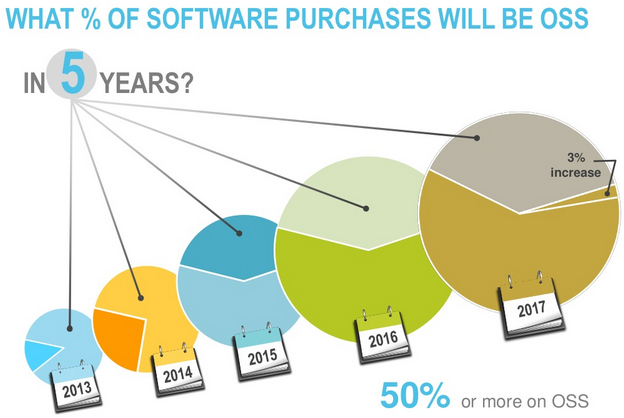
Open Source. A Success Story
Hint: This post was migrated from our former blog about SCM-Manager Universe. Therefore, the design is slightly different and some information might not be 100% applicable to Cloudogu EcoSystem. So don’t be alarmed; enjoy reading.
What comes into your mind when you hear open source? Do you think about something that came up several years ago, which is now a trend in software development? Or do you think about something that was there from the early days of the computer age, went through a difficult time and is now celebrating a renaissance? In this post we give a condensed overview on the history of open source, its characteristics and a prospect on where it might go.
The Beginning
The concept and development of open source systems already started in the late 1960s and early 1970s. The intention was to make operating systems and applications more independent from their particular hardware platform or vendor and hence prevent vendor lock-in. Most people associate the term “open source software” (OSS) with the name “Linux”, which was released in 1991, although it was not one of the first projects. “Unix”, the inspiration of Linux, was already developed in 1969.
But what makes a software project an open source software project? Well, it has to show the following characteristics (source):
- development transparency, no intentional secrets
- ability to inspect source code
- ability to modify source code
- expansive licensing
- community
- redistribution rights
Those characteristics ensure that everybody can take open source code and understand, change and extend it. A more obvious answer to the question is that the software is distributed under an open source license. The most common ones are:
- the GNU General Public License (GPL)
- the Berkeley Software Distribution (BSD) and
- the Lesser GPL (LGPL)
Those licenses have one thing in common, they include the right to edit and redistribute the source code of software.
In the 1990s, when the first kernel of Linux was released, open source software was not seen as a serious challenge of the established proprietary systems. Because back then there was a lack of strong standards that open source projects could use. Therefore many different standards were used and it was difficult to interlink OSS. That is why proprietary models that were widely used (e.g. Microsoft products) yielded stability and user satisfaction. At the end of the 1990s the situation changed and some companies announced that their new products would support existing open source software (e.g. IBM announced that their next WebSphere Application Server would fully support the Apache web server). This lay the foundation of a revival of open source software. Nowadays it can be said that OSS is mainstream.
Today
As mentioned at the end of the 20th century the importance of open source software rose. This fact is partly shown in the following figure, where the share of Windows applications, browser specific applications and OS neutral applications are distinguished. It shows the development from 1996 until today aswell as a forecast to 2020. “Operating system neutral” (OS neutral) is not synonymous to open source, but generally speaking open source software is OS neutral, because it does not use proprietary standards. Therefore a huge share of the OS neutral applications should be open source projects.
It can be seen that the share of open source applications rose from 5% in 1996 to 50% today and it will keep on growing. From 1996 to 2000 the graph stayed pretty stable. Till 2004 the share of OS neutral applications kept rising steadily. Until today the importance increased significantly. The forecast predicts that approximately 70% of all applications in 2020 will be operating system neutral. This leads to the question: Why is open source so successful?
Naturally this question is not easy to answer, because there is a wide variety of reasons. Let´s try it anyway:
- One of the major reasons is that the development of open source projects is problem oriented: someone has a problem and wants to solve it. Hence he starts a project and works on the solution.
- In many cases open source software creates a higher customer satisfaction than proprietary software, because users are encouraged to contribute and to suggest improvements (source).
- The quality of open source projects is equal to proprietary ones.
- OSS is based on an open structure (see characteristics of open source). This enables the integration of systems, which leads to the optimization of processes.
- But above all, it can be assumed that the most important difference between proprietary and open source projects was, and will be, the passion of the developers that are contributing to a project (source). This passion arises from the fact that someone is working on a topic he believes in.
Due to the high quality, open structure, customer satisfaction and passion open source applications are not only applied in private use. Companies are also using OSS more and more. The answers of companies from the automotive sector to the following question were as follows: “What is Your Company´s Relationship to Using Open Source Software in Your Products?”

A great share of companies (59%) are using open source software. One third of the participants is evaluating the usage and 21% are already contributing to at least one project. Only 15% don´t use open source software at all.
Despite this wide spreading, there are still barriers that complicate the first steps with open source software (source):
- unfamiliarity with open source solutions,
- a lack of internal technical skills and
- a lack of formal commercial support.
Those three obstacles can be overcome, because there are tendencies that counteract them:
- The lack of internal technical skills can be evaded by the use of “virtual appliances” which are increasingly common. These are virtual computer systems that are fully configured and ready to use by anyone. You only have to download the VM (Virtual Machine) and start it in a VM tool.
- Because there is a lack of formal commercial support, the number of commercial support providers for open source software is rising.
- The unfamiliarity with open source solutions can be overcome by evaluating open source solutions. In this case again the virtual appliances can help, because after downloading them you quickly get an insight of the software. After that you can perform individual configuration or a new installation on your system.
Because barriers don´t seem alarming nowadays the spreading of open source software is rising and more and more companies plan on expanding their OSS usage. The following figure shows that companies plan a rising purchase rate of open source software in the following years.

Examples of very successful open source projects that are widely used are Apache (more than 1400 committers), Mozilla (more than 1400 committers), Eclipse (more than 800 committers), MySQL, OpenOffice, or the Linux Kernel (more than 3000 committers). Especially in the case of Linux many people are using it without even knowing it, because Linux is widely used in embedded systems like smart phones or navigation systems (source).
The Future
It is very likely that the importance and maturity of open source software will keep on rising, because more and more companies start contributing to open source projects. This could lead to a combination of the best aspects of the two worlds: the passion from open source projects and the professional capabilities of companies. It will be interesting to see where this cooperation will end up.
In our case (Yes, we are contributing to an open source project and offering support for it!) we came across SCM-Manager a while ago and started using it because of the advantages it provides. After a while we wanted to integrate SCM-Manager more into our systems, therefore we wrote the Bugzilla-Plugin and made it public.
Just like in our case, there are lots of companies out there that are using their resources to contribute to open source projects (see figure 2). These are win-win-situations. The company can implement a new feature on its own, the project is enriched by one feature, it becomes more popular and more people and companies contribute to it.
The success story of open source projects started a long time ago and it can be assumed that it will keep on (see the first figure of the post). The passion of the contributors, the problem oriented development and the resulting high user satisfaction will take care of that.
With kind regards, your SCM-Manager Support Team
Note (13.04.2018): We removed some dead links from the post, because they were no longer valid.
SCM-Manager
The easiest way to share and manage your Git, Mercurial and Subversion repositories.
Getting started




